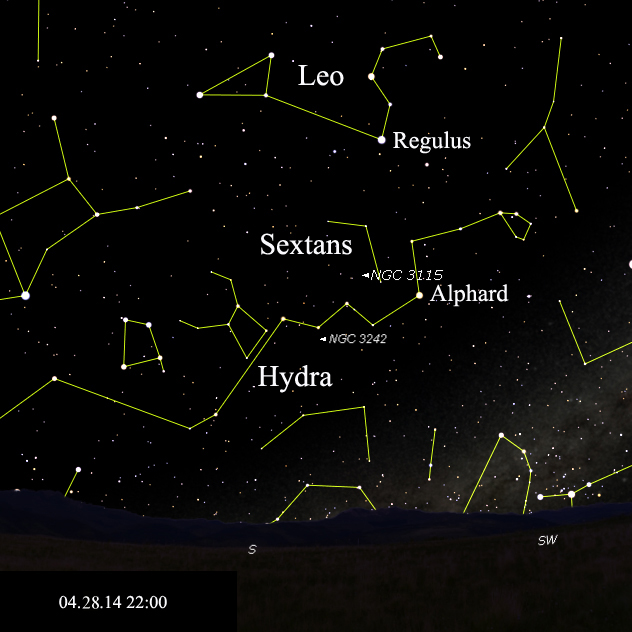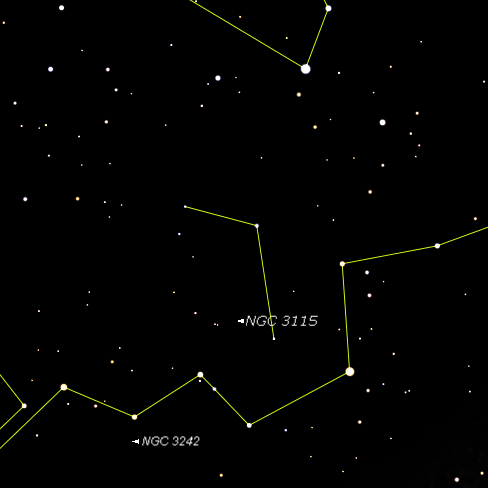
The night sky is quite varied, in terms of the sort of objects we can directly observe in our amateur telescopes, and their location relative to our home planet. Hydra is huge. It occupies the most celestial real estate of any constellation, but its size is stretched out over a long thin swath of sky, bordering both winter and summer constellations. And, for all its size, it contains only one bright star: Aphard, the bright star below Regulus, the more well-known star in Leo.
Between Hydra and Leo, near Aphard, is the small constellation Sextans. In these two constellations, close together, there are two particularly bright objects worthy of a visit. One is a planetary nebula NGC 3242, also known as "The Ghost Of Jupiter" in Hydra. The other is a bright galaxy NGC 3115, The Spindle Galaxy, in Sextans.
The Ghost of Jupiter is easy to find. The Spindle is a bit trickier, but still not difficult. Here is a chart showing their locations relative to the bright stars Regulus and Alphard:
NGC 3242 is a snap to star hop to. You should easily recognize Regulus in the familiar constellation Leo. So, just below, the only bright star is Alphard, shining yellow at magnitude 1.96. To its left, the stars in the constellation figure are dimmer, but you can see them in a finder, and have been describe as a flattened 'W,' Looking for the W will allow you to hop nicely to the right position.
What you will see in a low power eyepiece is a star that appears a bit out of focus, or fuzzy. You might also detect an odd color for that star - somewhat blue-green. The color is due to emissions of doubly-ionized oxygen in the atmosphere of the star, known as OIII. Stars at the end of their life cycle, if they are not big enough to become a supernova, will cast off shells of their atmosphere, becoming what is termed a Planetary Nebula, and that's what The Ghost of Jupiter is.
Why call them "planetary" at all, when they are not planets? In early rudimentary telescopes, before much detail could be discerned, objects such as this looked round and out of focus, much like a planet.
Try various filters on this object, an Orion Ultrablock filter will work well to cut down some of the brightness and reveal a bit of detail, but you will also lose the color when you do this.
Here is one of my observations of The Ghost of Jupiter from years ago:
"The Ghost of Jupiter usually appears to me as a very bright large planetary disc with little detail. Just a bright ball. In the 20" at 280X there was tons of detail. A small central dark disc with the central star - a pinpoint - popping in and out. A bright ring around the dark disc, then a grey diffuse oval around the bright ring... and... farther out, a large faint envelope of nebulosity. This was without a filter."
What can you see? Part of the fun is trying to get some detail, the other part is knowing, in amazement, what it is you're actually looking at!
The Ghost of Jupiter is bight at magnitude 8.9, and is 1400 light years from us. It is one of the thousands of discoveries of Sir William Herschel.
Check out this awesome customer image of the Spindle Galaxy.
Here is an image by Adam Block for the NOAO - but know now it will not appear like this in your telescope - note the details, several of which I saw visually in a larger telescope:
The Spindle Galaxy is also bright at magnitude 9.8. It appears much dimmer than the Ghost Of Jupiter as that "brightness" is spread out over a larger area than the concentrated light in The Ghost Of Jupiter. Compare those sizes and you'll understand - The Ghost of Jupiter is 25" in diameter, while the Spindle Galaxy is 7.2'x2.5'. That's 25 arc-seconds compared to several arc-minutes. No wonder galaxies appear so much dimmer than Planetary Nebulae!
Star Hop to the Spindle Galaxy:
Start at Regulus and draw an imaginary line to Alphard. I use this imaginary line as a clock dial, with Regulus at 12, and Alphard at the center of the clock. Then I imagine line out about 1/3rd the distance between Regulus and Alphard, extending out toward 9:30 on the clock face. That gets me in the right area to start sweeping in expanding circles with a low power eyepiece. Doing so will reveal this bright thin galaxy. Here is an image of NGC 3115 from The Digital Sky Survey:
My observing notes using an 18" telescope and 12mm eyepiece to view the Spindle Galaxy are as follows: "Very bright extremely compact core. Arms are very thin and very long. Stellar nucleus is noticeable inside small but elongated core. Arms to thickness ratio of at least 10x1, and bright. Highlight object."
The Spindle is about 30 million light years distant and was also discovered by Sir William Herschel.
Here is a detail of the area, for both targets, which should help you hop to them:
Using geometric shapes that you create in the sky, you can star hop to almost anything. Stop and look, and think about shapes in the sky. This hobby is a treasure hunt - use and hone your skills, and you'll have a lifetime of enjoyment from it.
Please, let me know what you see. I'd love your feedback.
Clear skies,
Mark Wagner
Mark Wagner is a life-long astronomy enthusiast and deep sky observer. He has spent the past twenty years popularizing amateur astronomy in the San Francisco bay area through his writing and community building. A past president of the San Jose Astronomical Association, he founded what is now the annual Golden State Star Party in California. Please post if you have comments, questions, sketches or images you've taken of the targets mentioned above.






















